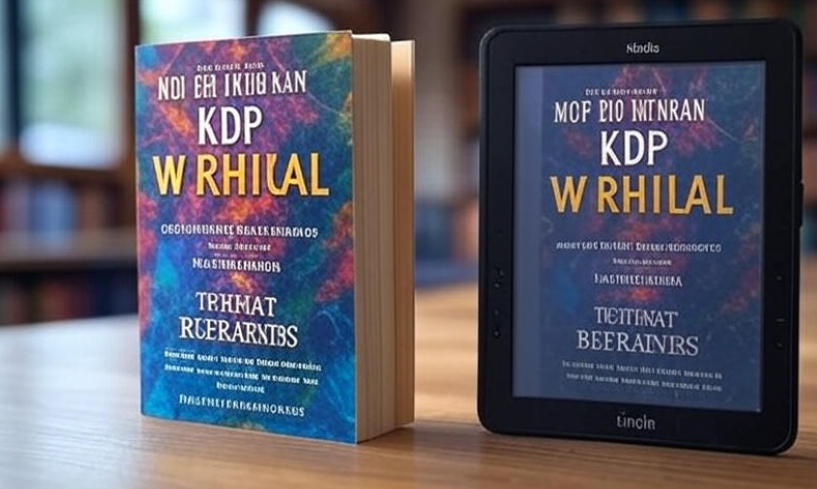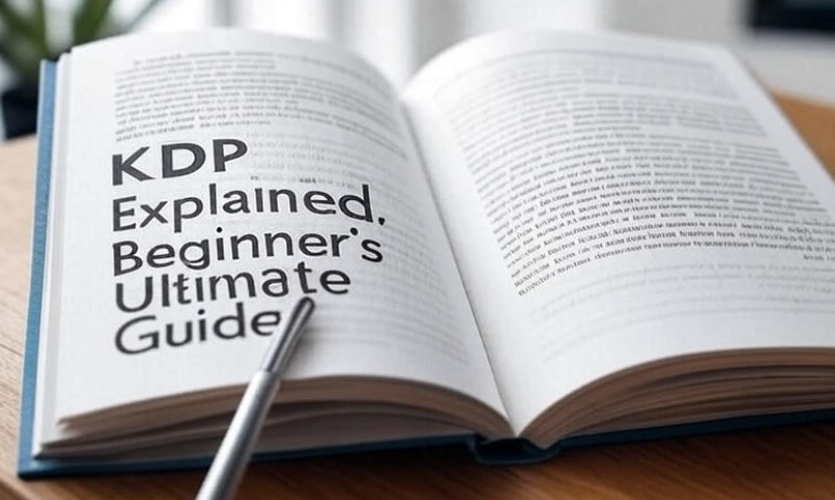Publishing your book through Amazon’s Kindle Direct Publishing (KDP) is one of the easiest ways to share your work with the world. But here’s the catch—when you publish on KDP, you’ll have two big options: releasing your book as a Kindle eBook 📱 or as a KDP Paperback 📖. At first glance, it might feel like these are almost the same thing, just in different formats. But if you dig a little deeper, you’ll find some major differences that affect not only your readers, but also your earnings, your marketing, and even the way your book looks.
So let’s break it down in the most straightforward way possible.
What KDP Paperback means
A KDP Paperback is the physical printed version of your book. Amazon prints copies on demand whenever someone orders it, so you don’t have to keep a stockpile of books in your garage. Think of it like a print shop that only prints when there’s demand. Readers love it because they get a “real” book in their hands—something they can flip through, underline, and even put on a shelf.
What Kindle eBook means
A Kindle eBook is the digital version of your book. Instead of pages you can touch, it’s a file that people can read on a Kindle device, a tablet, or even a smartphone using the Kindle app. With eBooks, there’s no paper, no printing, no shipping. It’s instant delivery worldwide. Someone in the U.S. or Europe could download your book seconds after you hit publish.
The reading experience: Paper vs. Screen
This is where the debate often starts. Some readers absolutely love the feel of paper—the smell of a new book, the weight of it in their hands, and the way they can highlight with an actual pen. Others prefer the convenience of an eBook, where you can adjust the font size, change the background color, and carry hundreds of books in one small device.
For authors, this matters because you need to know your target audience. If your readers are mostly young professionals who use tablets, eBooks might be a better fit. If they’re traditional book lovers, paperbacks will appeal more.
Costs of publishing
Here’s an important detail many beginners miss. Publishing a Kindle eBook costs you almost nothing. Amazon lets you upload your manuscript, set a price, and that’s it. No upfront printing expenses.
But with a Paperback, even though Amazon handles the printing, the production costs are higher. Every time a copy is sold, Amazon deducts printing costs (based on page count, ink, and paper quality) before giving you royalties. This means you earn less profit per paperback than per eBook, unless your book is priced high.
Royalties and earnings
Let’s talk money 💰.
-
Kindle eBooks usually give you two royalty options: 35% or 70%, depending on your pricing and the regions you sell in. Most authors aim for the 70% royalty rate, which applies if your book is priced between $2.99 and $9.99.
-
KDP Paperbacks typically give you 60% royalty minus printing costs. So if your book is priced at $12.99 and printing costs $4, you’d earn around $3.79 per sale.
It looks like paperbacks bring in more per sale, but that’s not always true once you calculate printing. eBooks, on the other hand, have zero printing expenses.
Distribution reach
Kindle eBooks have an edge here. Since they are digital, they can be bought instantly anywhere Amazon operates. That’s a massive audience. Plus, they can also be included in Kindle Unlimited or the Kindle Owners’ Lending Library, which gives you more exposure.
Paperbacks can also reach worldwide readers, but shipping adds cost and time. Some customers prefer instant reading rather than waiting days for delivery.
Control over design
With Paperbacks, design plays a huge role. You need a full cover layout—front, spine, and back. That means more work, but it also makes your book look professional. Readers often judge a paperback by its cover.
For eBooks, design is simpler. You just need a front cover image. The inside layout can be adjusted by the Kindle system, so you don’t need to worry as much about formatting details.
Reader perception
Here’s something subtle but very real: credibility. A physical book often feels more “serious” to readers. Many people still see paperbacks as more professional because they resemble traditional publishing.
eBooks, while popular, sometimes feel more casual. But don’t underestimate them—many bestselling authors today make the majority of their income from eBooks because of volume and global reach.
Flexibility in updates
Want to fix a typo or add new content? With an eBook, it’s super easy. You just upload a new file and Amazon pushes updates. Readers can access the changes almost instantly.
With paperbacks, it’s also possible, but trickier. If you change the content or formatting, you need to upload a new version. People who already bought the book won’t get the updated version.
Environmental impact 🌍
Some readers care about sustainability. eBooks are eco-friendly since there’s no paper or ink. Paperbacks, though loved by many, require physical resources for printing.
Here’s a quick comparison table
| Feature | Kindle eBook 📱 | KDP Paperback 📖 |
|---|---|---|
| Publishing Cost | Almost none | Printing costs per copy |
| Royalties | 35% or 70% | 60% minus printing |
| Distribution | Global instant download | Global but slower (shipping) |
| Design Needs | Front cover only | Full cover (front, back, spine) |
| Updates | Quick and easy | More complicated |
| Reader Experience | Adjustable, portable | Tangible, collectible |
| Credibility | Good, modern | Higher traditional feel |
| Environmental Impact | Eco-friendly | Uses paper & ink |

Which format sells better?
It depends on your niche. Romance, sci-fi, and self-help often do extremely well in eBook form because people read them on the go. Academic books, cookbooks, and children’s stories often sell better as paperbacks because people like holding them and referencing them physically.
A smart author usually publishes in both formats. That way, you don’t miss out on either audience.
If you’re publishing your first book, you’ll love this step guide: How to Publish Your First Book on Amazon KDP.
Marketing differences
Promoting an eBook is often easier online. You can run Kindle Countdown Deals, make it free for a few days, or promote through Kindle Unlimited. Paperbacks, however, can be physically handed to people at events, book fairs, or signings, which builds personal connections.
Personal example to think about
Imagine you’ve written a travel guide. If it’s on Kindle, a traveler could buy it right at the airport before boarding a flight ✈️. But as a paperback, it could be a beautiful coffee table book with maps and photos. Different purposes, different audiences.
So which one should you choose?
Honestly, don’t limit yourself. If you’re publishing through KDP, go for both. Upload an eBook to tap into the instant global market. Also upload a paperback to appeal to traditional readers who want something tangible. This way, you maximize your reach and income.
FAQs
1. Do I need an ISBN for both formats?
Amazon provides a free ISBN for paperbacks. For eBooks, you don’t need an ISBN unless you want to publish outside Amazon.
2. Can I set different prices for eBooks and Paperbacks?
Yes. In fact, most authors set the eBook at a lower price (like $2.99–$4.99) and the paperback higher (like $9.99–$14.99).
3. Which one pays faster?
Both pay on the same KDP schedule—usually 60 days after the end of the month of sale.
4. Can I make more money with eBooks or Paperbacks?
It depends. eBooks often sell more copies because of the low price and instant delivery, but paperbacks usually bring higher per-unit earnings.
5. Do readers prefer one over the other?
Some do. Younger audiences lean toward eBooks, while older or more traditional readers prefer paperbacks. Many people actually buy both formats of the same book.
Final Thoughts
The debate of KDP Paperback vs Kindle eBook isn’t about which is better. It’s about which works best for your goals. If you want global reach, fast updates, and low cost, eBooks are unbeatable. If you want credibility, physical presence, and that classic “author feel,” paperbacks are essential.
The smartest strategy? Don’t choose one—publish both. That way, whether your reader wants to swipe a screen or flip a page, your book is right there waiting for them.
📚 After all, the format matters less than the story you’re telling.




